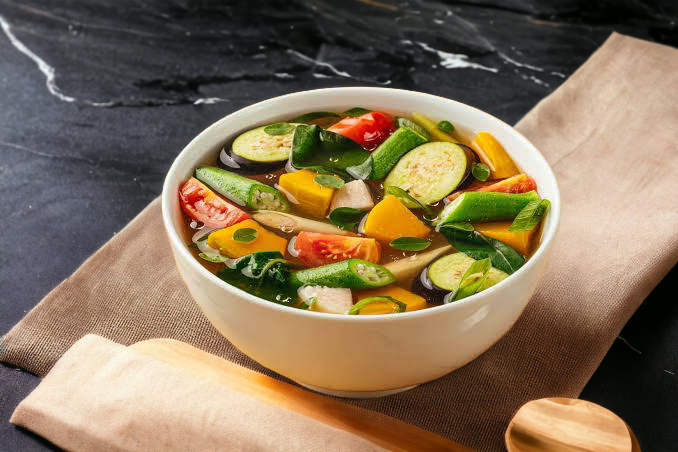Embark on a gastronomic adventure as we guide you through the step-by-step process of cooking Lawuy, a delicious Filipino vegetable and fish stew. Discover the harmony of flavors and cultural significance behind this traditional dish, while customizing it to suit your taste. Join us as we celebrate the beauty of locally-sourced ingredients and the joy of communal dining with Lawuy.
Welcome to our creative kitchen, where we're about to take you on a flavorful journey with a Filipino classic dish called Lawuy. This hearty vegetable and fish stew is not only delicious but also packed with nutrients. In this blog post, we'll guide you through the process of cooking Lawuy step by step. Prepare your taste buds as we explore the beautiful combination of flavors and textures that make this dish truly special.
1: Gathering the Ingredients
To start off, let's gather all the fresh ingredients required to create this delicious Lawuy dish. You'll need the following items: 1 pc Gabi, 1 pc Ginger, 1 stalk Lemongrass, 3 cups Water, 1 cup Kalabasa, 1 pc Eggplant, 0.5 cup Okra, 0.5 cup Patola, 2 pcs Galunggong, 1 pc Red Onion, 2 stalks Onion Springs, 0.25 cup Malunggay, and 0.2 cup Saluyot. These ingredients will form the foundation of the dish and provide a mix of flavors that will tickle your taste buds.
2: Preparing the Ingredients
Now that we've gathered our fresh ingredients, it's time to prepare them for cooking Lawuy. Start by washing all the vegetables and fish thoroughly to remove any dirt or impurities. Peel the Gabi and ginger, and chop them into smaller pieces for easier blending later. Slice the lemongrass into smaller sections, ensuring they're easy to remove from the dish before serving. Cut the kalabasa, eggplant, okra, and patola into bite-sized pieces, ensuring uniformity for a visually appealing dish. Finally, clean the galunggong, removing the scales and innards while keeping the fish intact.
3: Sautee and Flavor Infusion
The secret to a mouthwatering Lawuy lies in the harmonious blending of flavors. Heat up a large pot and add a generous amount of oil. Now, sauté the red onion, ginger, and lemongrass until they release their irresistible aroma. As the kitchen fills with tantalizing scents, pour in the water and bring it to a boil. Allow the ginger and lemongrass to work their magic, infusing the liquid with a depth of flavor that will infuse every ingredient added later.
4: Adding the Vegetables
Once the broth is boiling, it's time to add the chopped kalabasa, eggplant, okra, and patola to the pot. Allow the vegetables to simmer in the flavorful liquid until they become tender but not overcooked. Be careful not to let the vegetables lose their crunch, as their texture adds a lovely contrast to the softness of the fish.
5: Time for the Galunggong
The star of the show, the galunggong, is ready to take its rightful place in our Lawuy masterpiece. Gently place the cleaned galunggong into the pot, carefully allowing the simmering broth to envelop it. The fish's natural oils will mingle with the flavorful broth, elevating the taste to new heights. Leave the pot to simmer until the galunggong is cooked through and easily flakes with a fork.
6: Adding the Finishing Touches
As the galunggong finishes cooking, it's time to add the final accents that will complete the Lawuy experience. Finely chop the onion springs and sprinkle them into the pot, giving the dish a burst of freshness. Follow this by incorporating the malunggay and saluyot, two greens that not only add vibrant color but also contribute beneficial nutrients. Allow the pot to simmer for a few more minutes, ensuring that the flavors meld together beautifully.
7: Serving the Lawuy
Congratulations, you've successfully cooked Lawuy! Carefully transfer the aromatic Lawuy into a serving bowl and inhale the delightful scent wafting through the air. As you admire the colorful medley of vegetables and fish, serve the Lawuy hot and steaming, maintaining its authentic charm. Pair it with a bowl of freshly cooked rice and enjoy the culmination of your hard work in this heartwarming dish.
8: Lawuy Variations and Customizations
While Lawuy is traditionally cooked with galunggong, there are endless possibilities for customizing this dish to suit your preferences. Feel free to experiment by substituting different fish varieties, such as tilapia or bangus, or even adding prawns for an extra touch of indulgence. For those seeking a vegetarian option, tofu makes a wonderful alternative to fish, contributing a unique texture to the Lawuy. Personalize the dish to your liking, and let your creativity shine.
9: The Cultural Significance of Lawuy
Lawuy holds a special place in Filipino culinary culture, representing the simple beauty found in local ingredients and traditional cooking methods. Passed down through generations, this dish symbolizes togetherness, as families gather to enjoy a hot bowl of Lawuy and share stories. Embrace the cultural significance of Lawuy as you savor each bite, knowing that you're taking part in a culinary tradition that has stood the test of time.
Cooking Lawuy is a delightful culinary adventure, immersing you in the flavors and cultural heritage of the Philippines. By following this simple, yet flavorful recipe, you can recreate this beloved dish right in your own kitchen. So, gather the ingredients, let the fragrant spices dance in your pot, and indulge in the comforting warmth of Lawuy - a dish that nourishes both body and soul.






No comments:
Post a Comment